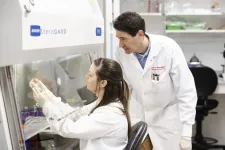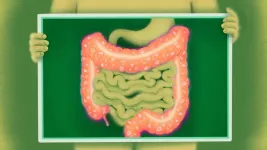(Press-News.org) PHILADELPHIA – Increasing patients’ out of pocket costs for HIV pre-exposure prophylaxis (PrEP), medications, which have been shown to dramatically reduce the risk of HIV infection, could lead to a significant reduction in PrEP use and a rise in HIV infection rates, according to a new study co-led by researchers at the Perelman School of Medicine at the University of Pennsylvania and Johns Hopkins Bloomberg School of Public Health.
The study, published today in Health Affairs, was designed, in part, to explore the impact that out-of-pocket cost increases could have, depending on the outcome of an ongoing court case challenging certain provisions of the 2010 Affordable Care Act (ACA).
The researchers used a large, proprietary database of medical and pharmacy claims to determine the rates at which patients failed to fill (i.e., abandoned) insurer-approved PrEP prescriptions at different levels of out-of-pocket costs. Their findings suggest that even a small increase, from $0 to $10 in monthly PrEP out-of-pocket costs, would double the rate of PrEP prescription abandonment. Further, an increase in out-of-pocket costs to between $100 and $500 per month would result in nearly one-third of patients abandoning their PrEP prescriptions.
The analysis also highlighted the negative consequences of abandoning PrEP: The rate of new HIV infections in the year after the initial PrEP prescription was two to three times higher among those who never filled those prescriptions.
“Our findings suggest that out-of-pocket cost increases for PrEP could upend the progress that has been made towards ending the HIV/AIDS epidemic in the United States,” said study senior author Jalpa Doshi, PhD, a professor of Medicine and the director of Value-based Insurance Design Initiatives at the Center for Health Incentives and Behavioral Economics at Penn Medicine.
To date, the FDA has approved two HIV PrEP products, each of which combines two standard antiretroviral drugs in a single pill. For the past decade, the U.S. Centers for Disease Control and Prevention (CDC) has recommended PrEP as a way of preventing HIV infection among higher-risk individuals. Expanding access to PrEP is also one of the central pillars of the CDC’s Ending the HIV Epidemic in the U.S. (EHE) initiative, which seeks to reduce new HIV infections in the United States by 90% by 2030. In 2019, the U.S. Preventive Services Task Force (USPSTF), an independent group of experts on disease prevention, gave PrEP an “A” rating. Under a provision of the ACA, that rating has meant that, since 2021, most private insurance plans have been required to provide PrEP to policyholders without cost sharing.
However, an ongoing legal challenge (Braidwood Management, Inc. v. Becerra) may nullify that part of the ACA, allowing insurers to now require out-of-pocket costs for PrEP and other preventive therapies. Against this background, Doshi and her colleagues sought to gauge how out-of-pocket cost changes affect PrEP use.
The team reviewed a U.S.-wide database covering insurer-provided health care, including prescription records, dating from 2016-2018. They analyzed this dataset to determine the rate of PrEP prescription abandonment—defined as a patient not picking up their newly-prescribed and insurer-approved PrEP prescription from the pharmacy within 365 days —at different out-of-pocket cost levels. Their analysis covered 58,529 patients with new, insurer-approved PrEP prescriptions, and adjusted for differences among the patients. Refills did not feature in the analysis.
They found that both the rate of PrEP prescription abandonment and the rate of delayed prescription fills increased as out-of-pocket costs rose. Also, patients who abandoned their PrEP prescription were two to three times more likely to get infected with HIV in the following year, compared to those who filled their PrEP prescription.
Based on their analyses, the researchers estimated that raising monthly patient out-of-pocket costs for PrEP from $0 to the $1-$10 category would nearly double the prescription abandonment rate (from 5.6 percent to 11.1 percent), while moving to the $101-$500 category the abandonment rate would be 34.7 percent. At the $500+ category, they estimated, the abandonment rate would be about 42.6 percent, nearly eight times the rate at the $0 level.
Overall, the results suggest that even a modest increase in patient out-of-pocket costs for PrEP could result in a sharp increase in prescription abandonment—and a subsequent large increase in the rate of new HIV infections.
The study was co-led by Lorraine Dean, ScD, Associate Professor at the Johns Hopkins Bloomberg School of Public Health. The research was supported by the National Institutes of Health (R21NR018387, R01NR017573, R25MH083620, and T32AI102623).
###
Penn Medicine is one of the world’s leading academic medical centers, dedicated to the related missions of medical education, biomedical research, excellence in patient care, and community service. The organization consists of the University of Pennsylvania Health System and Penn’s Raymond and Ruth Perelman School of Medicine, founded in 1765 as the nation’s first medical school.
The Perelman School of Medicine is consistently among the nation's top recipients of funding from the National Institutes of Health, with $550 million awarded in the 2022 fiscal year. Home to a proud history of “firsts” in medicine, Penn Medicine teams have pioneered discoveries and innovations that have shaped modern medicine, including recent breakthroughs such as CAR T cell therapy for cancer and the mRNA technology used in COVID-19 vaccines.
The University of Pennsylvania Health System’s patient care facilities stretch from the Susquehanna River in Pennsylvania to the New Jersey shore. These include the Hospital of the University of Pennsylvania, Penn Presbyterian Medical Center, Chester County Hospital, Lancaster General Health, Penn Medicine Princeton Health, and Pennsylvania Hospital—the nation’s first hospital, founded in 1751. Additional facilities and enterprises include Good Shepherd Penn Partners, Penn Medicine at Home, Lancaster Behavioral Health Hospital, and Princeton House Behavioral Health, among others.
Penn Medicine is an $11.1 billion enterprise powered by more than 49,000 talented faculty and staff.
END
Orlando, Fla - More than two in five U.S. adults suffer from obesity, an epidemic that continues to trend upward. While bariatric surgery is an extremely effective treatment option, a new national survey by Orlando Health reveals common stigmas that may deter those who qualify for surgery from pursuing the treatment they need.
“Treatment plans for obesity are tailored to each individual patient based on things like body mass index and existing medical conditions and may include medication, lifestyle changes, counseling and bariatric surgery,” said Andre Teixeira, MD, medical ...
The spectacular explosion of the mine at Hawthorn Ridge – a fortified German front-line position in the First World War – marked the beginning of the Battle of the Somme, and remains one of the best-known pieces of film from the whole conflict.
More than 60ft below the surface, British miners had dug a gallery for more than 900 metres from their lines and packed it with 40,000 lbs of explosives. It was one of 19 mines placed beneath German front positions that were detonated on 1st July, 1916 to mark the start of the offensive.
But the detonation of the ...
A recent study found changes in blood flow in the retina could explain why some migraine patients experience visual symptoms. The findings could represent a long-sought observable marker for migraines that doctors can use to aid in the clinical treatment of the condition.
While patients with migraines often experience symptoms such as pain around the eye, sensitivity to light, blind spots and visual blurring, the mechanisms behind those symptoms have not been well understood. UCLA Health researchers used a non-invasive imaging technique, known as optical coherence tomography angiography, or OCTA, ...
A network of scientists across the globe have identified more than 700 plant genera named for women. This is a nearly twenty-fold increase in the number of genera linked to women before the group started working on the list.
The project, which aimed to highlight the contribution of women to botany, was the result of social media conversations about plants named for people.
What began as a simple question about how many and which plant genera were named for women evolved into a global network of scientists who built ...
When the body encounters bacteria, viruses or harmful substances, its innate immune cells, neutrophils, assemble at the site to combat the invader.
Bacteria and viruses have ways to avoid these defenses, however. Yersinia pestis, the bacteria that causes bubonic and pneumonic plague, for example, can hide from the immune system, allowing it to replicate in the body unhindered until it can overwhelm the host. This ability allowed Y. pestis to spread bubonic plague across Europe in the 14th Century, killing a third of the European population.
While plague may not be a serious threat to human health in modern times, researchers at the University of Louisville are studying Y. ...
A paper published in Nature Communications Biology contributes to the growing appreciation for the outsize role that microbes play in everything from human digestion to crop yields: Microbes in the soil—fungi in this case—appear to be influencing forest diversity on a global scale.
Forests on Earth exhibit a marked gradient from the equator toward the poles: Tropical forests near the equator tend to include a large number of different species, whereas forests nearer the poles support less plant diversity.
One explanation for this phenomenon maintains that soil pathogens, including bacteria and fungi, help create this gradient. ...
How can health care systems increase diversity and inclusion in their workforce?
UC Davis Health, recognized by Forbes as a "Best Employer in California", has developed a road map for increasing workforce diversity across the industry. While California banned the consideration of race or ethnicity in hiring at public institutions in 1996, UC Davis Health has since come up with a holistic outreach and local recruitment plan that has proven effective. And that approach is now receiving global attention through a new case study published in New England Journal ...
A study conducted by researchers at Ruppin Academic Center in Israel and Columbia University documents the broad impact on the mental health of Israelis, both Jews and Arabs, with sharp increases in post-traumatic stress disorder (PTSD), depression, and anxiety in the aftermath Hamas' attack in October.
The study, published in the Lancet’s EClinicalMedicine Jan. 5, 2023, found the prevalence of probable PTSD, depression, and anxiety in the weeks following the attacks (29% for PTSD, ...
(Santa Barbara, Calif.) — Scientists have solved a cellular murder mystery nearly 25 years after the case went cold. Following a trail of evidence from fruit flies to mice to humans revealed that cannibalistic cells likely cause a rare human immunodeficiency. Now the discovery shows promise for enhancing an up-and-coming cancer treatment.
“This paper takes us from very fundamental cell biology in a fly, to explaining a human disease and harnessing that knowledge for a cancer therapy,” ...
Researchers at the University of Michigan Health Rogel Cancer Center have identified a mechanism that causes severe gastrointestinal problems with immune-based cancer treatment.
They also found a way to deliver immunotherapy’s cancer-killing impact without the unwelcome side effect.
The findings are published in Science.
“This is a good example of how understanding a mechanism helps you to develop an alternative therapy that’s more beneficial. Once we identified the mechanism causing the colitis, we could then develop ways to overcome this problem and prevent colitis while preserving the anti-tumor effect,” said senior ...




